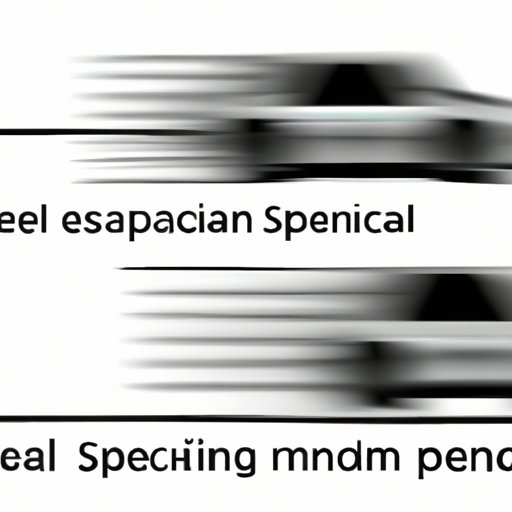Introduction
Speed is a term we hear often in everyday language, but what does it mean in science? In scientific terms, speed is the rate at which something moves or changes over time. This can be measured in units such as meters per second (m/s) or kilometers per hour (km/h). It’s important to note that speed and velocity are two different things – speed is the rate at which an object moves, while velocity is the direction and magnitude of an object’s motion.
Examining the Role of Speed in Scientific Experiments
When conducting a scientific experiment, scientists need to measure the speed of an object in order to determine the effect of their experiment on the results. To do this, they use a variety of instruments, such as stopwatches, accelerometers, and photogates. These instruments measure the speed of an object in different ways, such as measuring the time taken for an object to travel a certain distance, or measuring the rate of change in velocity over time.
For example, a stopwatch measures the time it takes for an object to travel a fixed distance, while an accelerometer measures the rate of change in velocity over time. Photogates measure the time it takes for an object to pass through a light beam, which can then be used to calculate the speed of the object.
The results of these measurements can have a significant impact on the results of an experiment. For example, if an experiment requires the object to travel at a certain speed, any deviation from that speed could alter the results of the experiment.
Investigating the Relationship Between Speed and Distance
In order to understand the relationship between speed and distance, it’s helpful to look at the equation that connects them: speed = distance / time. This equation states that the speed of an object is equal to the distance it has traveled divided by the time it took to travel that distance.
Using this equation, it’s possible to calculate the speed of an object from its distance and time. For example, if an object travels a distance of 100 meters in 10 seconds, its speed would be 10 m/s (100 / 10).

Comparing Different Types of Speed Measurements
There are several different types of speed measurements that scientists use to measure the speed of an object. The most common type of measurement is acceleration, which is the rate of change in velocity over time. Velocity is the speed of an object in a particular direction, while instantaneous speed is the speed of an object at a single point in time.
Acceleration is used to measure how quickly an object is speeding up or slowing down, while velocity is used to measure how fast an object is moving in a certain direction. Instantaneous speed is used to measure how fast an object is moving at a single point in time, such as when crossing the finish line of a race.

Examining the Impact of Speed on Modern Technology
Speed plays an important role in modern technology, as it can affect the performance of devices. For example, faster processors enable computers to run more efficiently, while faster internet connections allow for faster data transfer speeds. Similarly, faster cars and planes enable us to travel further and faster than ever before.
In addition, speed is also essential for some technologies, such as GPS navigation systems. GPS systems rely on satellites to calculate the location of an object, and the speed of the object is an important factor in determining its position. Without a reliable speed measurement, the accuracy of the system would be significantly reduced.

Understanding the Role of Speed in Scientific Principles
Speed plays a key role in several scientific principles, such as Newton’s Laws of Motion, the Theory of Relativity, and the Conservation of Energy. Newton’s Laws of Motion describe the relationship between force, mass, and acceleration, while the Theory of Relativity explains how space and time are affected by gravity and speed. Finally, the Conservation of Energy states that energy can neither be created nor destroyed, but only changed from one form to another.
Without speed, these principles would not be able to accurately describe the behavior of objects in motion. For example, Newton’s Laws of Motion require the speed of an object to calculate the force applied to it, while the Theory of Relativity relies on the speed of light to explain how space and time are affected by gravity.
Conclusion
Speed is an important concept in science, as it affects many aspects of scientific experiments, modern technology, and scientific principles. By understanding the physics behind speed and velocity, scientists are able to measure the speed of an object and use it to analyze the results of an experiment. Speed also plays an important role in modern technology, as it can affect the performance of devices, and is essential for technologies such as GPS navigation systems. Finally, speed is an integral part of several scientific principles, such as Newton’s Laws of Motion, the Theory of Relativity, and the Conservation of Energy.
(Note: Is this article not meeting your expectations? Do you have knowledge or insights to share? Unlock new opportunities and expand your reach by joining our authors team. Click Registration to join us and share your expertise with our readers.)
